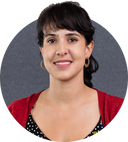Q:WhatdoesmicroTERRA do?

A:Wetakefishfarmwastewaterandgiveittoourmicroalgae.Theycleanthewatersoitcanbereused.Thisalsohelpsstopdownstreampollution.Thatcandestroy ecosystems.
Ourcompanyusesspecialmicroalgae.Throughphotosynthesis, theyproduceprotein.Weprocesstheproteinfromthemicroalgaeintofoodforthe fish.
Q:Howdoyougrow the microalgae?

A:Westartinthelabonasmallscale.Weknowwhatthemicroalgaelike.Weknowwhattheyneedtogrow.Andweknowwheretheythriveingeneral.But,wehavetoscaleupbecauseagricultureis huge.

Q:So,toscaleitup,youhavetogrowmassiveamountsof microalgae?

A:Yes.Wehavebioreactorswherethemicroalgaegrow.Wealsobuiltaharvestertocollectthebiomass.Theharvesterhadtoholdlargequantitiesofwastewater.Ithadtobecheapandeasytomanage, too.

Microalgaeconvertexcessnutrientsinwaterintoprotein.Theyalsorelease oxygen.
Q:Isitdangeroustoworkwith wastewater?

A:Wastewaterisfullofharmfulbacteria.Weuseglovesandwearmasksandgowns.Everything in thelab hastobedisinfectedacoupleof times.

Floresexaminesatankfullofwastewaterand algae.
Afarmcreates wastewater.
Wastewaterisprocessedwith microalgae.
Cleanwaterandproteinare produced.
Proteinismadeintofish food.
Foodisusedtofeedfishon
the farm.
CircularEconomy






Q:Doyouhaveanyadvicefor future environmental
scientists?

A:Iwouldsaytostartonsmallprojects.Thinkofdifferentwaystoreducewasteorpollutants.Howaboutatinywatertreatmentpond?Everyexperimentcounts!Tellothersaboutwhatyouaredoing.Shareideasandsolveproblems together!